Observations made with NASA's Spitzer Space Telescope, as well as with telescopes on the ground, managed to discover a solar system consisting of seven rocky planets, similar in size to Earth. The planets are very close to their parent star, but because the star is very small and much colder than the Sun, they are not exposed to a huge amount of sunlight. Three of these planets are in the "seat zone" of the star, where they receive an amount of light that allows, under the right conditions, liquid water to exist on the surface.
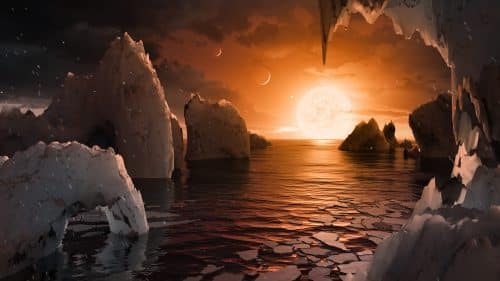
The seven discovered planets orbit the dwarf star TRAPPIST-1, located in the direction of the constellation Aquarius, about 40 light years away from us. Their size is very similar to that of the Earth, and their estimated density indicates a rocky composition. Three of the seven are inthe sitting area of the star - the appropriate distance where the estimated temperature allows the stable existence of liquid water. This is the largest discovery so far, around a single star, of planets that may contain liquid water - the key condition for life as we know it.
The discovered planets are very close to their parent star. They are numbered in alphabetical order according to their distance from the mother star - b, c, d, e, f, g, h. The closest planet, b, is only 1.5 million km from the star, about 1% of Earth's distance from the Sun. Due to their close proximity to the star, their orbital period is much shorter than that of the Earth - ranging from 1.5 days for the nearest planet b and 12 days for the sixth planet at its distance g. The seventh planet, h, has only been observed once so the data about it is inconclusive, but it orbits TRAPPIST-1 probably about every 20 days.
Despite being very close to their star, the discovered planets are not exposed to a huge amount of light, this is because TRAPPIST-1 is small and much less massive than the Sun, and therefore also colder. With a mass of only 8% of that of the Sun and a radius of 11% of it, it is considered "An ultra-cold dwarf", the coldest also relative to the other stars in the red dwarf family, stars smaller and colder than the Sun that make up most of the stars in the universe.
"The seven wonders of TRAPPIST-1 are the first Earth-like planets discovered orbiting a star of this type," he said In a message from NASA Michael Gillon from the University of Liege in Belgium and the lead author of the study, whose findings Were published Yesterday in the journal Nature. "It is also the best target so far for studying atmospheres of Earth-like worlds that may allow the existence of life."
The system's innermost planets, b and c, probably receive too much light to allow liquid water to exist on their surfaces, and the outer two, g and h, too little light. The inner planets e, d, and f, on the other hand, are said to be in the ideal place for liquid water.
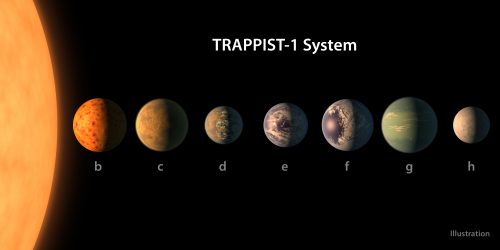
TRAPPIST-1 is named after the Planet Search Survey TRAPPIST, which uses two small telescopes in Morocco and Chile to search for extrasolar planets. In 2016, a team of researchers from the project, led by researcher Michel Gilon, announced that he had found three Earth-like planets around him. However, since the data regarding the third planet did not satisfy the researchers, they decided to make further observations of this solar system. They were assisted by a large number of telescopes on the ground, including the "Very Large Telescope" (VLT) in the Atacama Desert in Chile and the relatively small telescopes, located in Chile and Morocco, of the TRAPPIST project. But most of the data that made the new discovery possible was provided by NASA's Spitzer Space Telescope, which observed this fascinating solar system for 20 consecutive days.
The Spitzer Space Telescope was launched in 2003 to make observations in the infrared region of the electromagnetic spectrum. Although since 2009 it has run out of the cooling material that allows it to make very precise measurements in the infrared range, it is still active and specially adapted to make observations of stars such as TRAPPIST-1, which, due to their relatively cold temperature, radiate mainly in the infrared range.
From the new observations made, the researchers ruled out the existence of that third planet found in the previous discovery from 2016, but instead found five more planets, bringing the number of planets in the planetary system to seven.
The planets were discovered indirectly through “The eclipse method", in which the brightness of the star is measured accurately for an extended period of time. The existence of the planets is inferred through the detection of small and periodic decreases in the brightness of the star, which indicate some object - the planet - moving between the star and the observer, and causes part of the star's light to be hidden.
Using the periodic eclipses created by the planets, the researchers were able to determine their distance and their radius - the size of five of them is similar to that of the Earth, and two are slightly smaller than it.
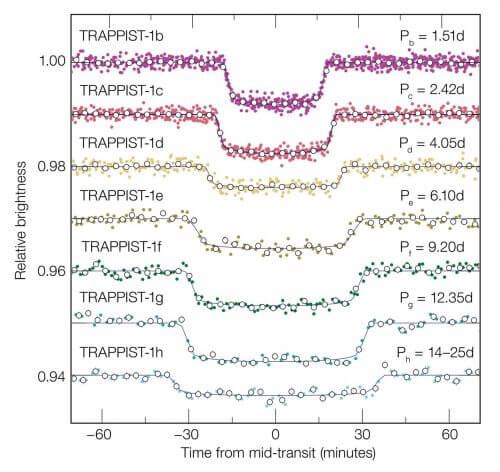
The researchers were able to determine the mass of the planets by measuring small disturbances in the timing of the eclipses, which are caused by the gravitational interactions of the planets with each other (a method known as Transit Timing Variation). Using the radius and mass, the researchers could also determine their density, and thus learn about their rocky composition. The density of one of the planets, f (which is in the Hashiv region), has been measured precisely enough to conclude that it also contains a significant amount of some volatile material, which could be water.
The discovered planets are very close to each other, and according to NASA, whoever stands on one of them will be able to see the other planets moving quickly across the sky. Some of them will even appear larger than our moon, and it will be possible to distinguish even certain geological details on them.
In fact, according to the researchers, TRAPPIST-1's planetary system somewhat resembles the lunar system of Jupiter, which has four large moons, The Galilean moons. Although the mass of the dwarf star is 83 Jupiter masses, it is very similar to Jupiter in size, and the orbits of the planets are not very different from those of Jupiter's moons. the researchers Please specify Also because the mass ratio of TRAPPIST-1 and the six nearest planets in its system is the same as the mass ratio of Jupiter and its four largest moons (~0.02%). From this, the researchers raise the possibility that the discovered planets were formed in a manner reminiscent of the supposed formation of Jupiter's moons - further away from their current location very close to the star, and that they later migrated inward.
The chairman of the Israeli Space Agency, Prof. Itzik Ben Israel, said in response to the publication of the findings: "The discovery substantiates the hypothesis that the number of planets in the universe that have conditions that allow life is large and enormous, so that the chance that there is life outside of ours is not at all as small as was previously thought few years".
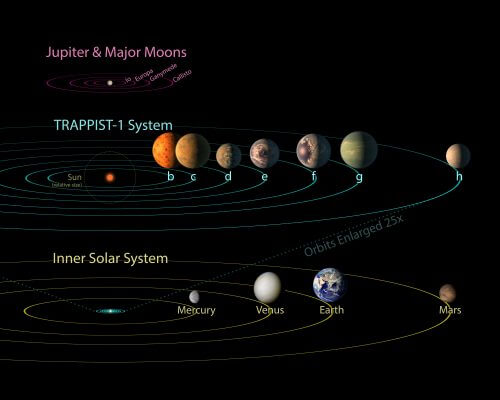
Despite the fascinating discovery that shows how widespread planets like Earth are throughout the universe, it must be remembered that there is still much hidden over the visible. One of the main questions is whether they have an atmosphere and what the composition is. The researchers noted that the amount of light that the three planets in the sitting area receive is very similar to the amount of light received by the inner planets in our solar system - planet d is at a distance where it receives the same amount of light as Venus, e receives the same amount of light as Earth, and f receives as much light as Mars. In our solar system, as we know, only the Earth has an ideal atmosphere with a moderate greenhouse effect, which allows the existence of liquid water on the surface.
In addition, Earth-like planets around red dwarfs are easier to detect with today's technology, due to the relatively weak light of the red dwarfs, but they may be problematic for sustaining life. In their youth, red dwarfs are very active, and many solar flares occur in them. Planets, and especially the planets that have been discovered so far and are very close to their star, are exposed in such a situation to a very large amount of X-ray and ultraviolet radiation. According to a recently published study According to researchers from NASA, planets exposed to such radiation will lose their water reserves in tens or hundreds of millions of years, a relatively short time in astronomical terms.
Another problem that red dwarf planets face is "gravitational locking", where they always face the same side to their star, similar to how the moon always faces the same side to Earth. Due to the close proximity of the planets to TRAPPIST-1, the researchers estimate that they will all be in a state of gravitational lock. In such a situation, if there is no atmosphere, there will be huge temperature differences between the two sides of the planet, with one icy and the other hot. If an atmosphere exists it can moderate these differences.
The researchers hope that further observations will reveal more details about the planets, and gauge their ability to support liquid water on the surface of the ground. The researcher Michel Gillon said that additional observations by the Spitzer Space Telescope have already been made, and the exact orbital and physical data of the planets will help.
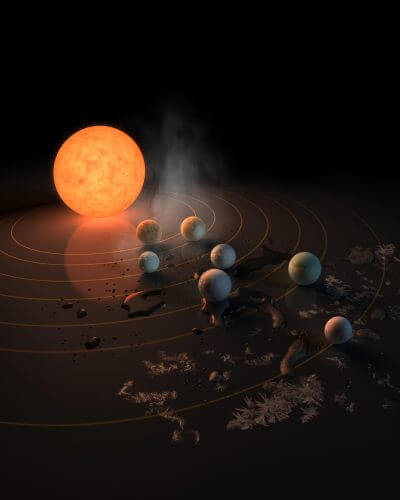
The Hubble and Kepler space telescopes also joined the efforts to study the discovered system. Kepler, which was sent into space specifically for measuring the brightness of stars, to look for planets around them, will make it possible to more accurately determine the orbital characteristics of the planets, and possibly discover more planets. Hubble Space Telescope performed recently An observation of the system, which made it possible to determine that its two innermost planets do not have a dense atmosphere of helium, as gas giants have, thus strengthening the hypothesis that they are rocky planets like Earth.
Observations by future telescopes will also make it possible to study the composition of the planets' atmospheres. The James Webb Space Telescope, which NASA plans to launch next year, will have such high sensitivity that it will be able to detect the chemical signatures of water, methane, oxygen, ozone, and other components in the atmospheres of the planets. Additional observations are also planned using the "exceptionally large European telescope" (European Extremely Large Telescope) which is currently being built in the Atacama Desert in Chile, and is expected to start operating in 2024. With a primary mirror measuring 39 meters, the telescope will provide images 16 times sharper than those of the Hubble Space Telescope.
See more on the subject on the science website:
- A terrestrial planet has been discovered around Proxima Centauri, the closest star to the Solar System
- Is there life on the nearest planet, Proxima Centauri b?
- Life at the seam between the bright side and the dark side: the James Webb Space Telescope will be able to examine the composition of the atmosphere of Proxima Centauri b
- The search for a second Earth
- NASA Announces 1,284 New Extrasolar Planets - Largest Harvest to Date

6 תגובות
wow, wow, wow, wow,
Note that in the past it was known that the star probably had three planets and now it is known that there are seven. Maybe there are other stars that seem to us to have one or two stars and actually have more? Do our methods make us miss counting planets? However, the discovery may suggest that there are more planets than we currently think (which is an average of one planet per star).
Another thing that can be learned from the discovery is the prevalence of terrestrial planets. To the best of my understanding at the moment, the estimate is that there are about 10 billion terrestrial planets in our galaxy alone. Now we lack the figure of how many of these DH-like planets have an atmosphere, in order to go one step further and close another variable in the Drake equation for the chances of extraterrestrial life.
An interesting fact that is mentioned here is that the chances of an atmosphere around red dwarf stars are smaller because the radiation in them in the first years is high and causes erosion of the atmosphere. The question is, are there conditions in one of the stars that the atmosphere will be formed at a later stage than in XNUMX? And what about a water star? What effect does radiation have on starfish? Will life in the depths of the oceans be protected from radiation damage?
Thanks for the feedback Elisaf, do you know how long it takes to process
All the data up to the production of the titles with high probability in your article?
In 2009, the Spitzer space telescope ran out of the cooling material that allowed it to reach very low temperatures of only about 5 Kelvin, but even without the cooling material it is able to perform passive cooling (through protection from sunlight) which brings it to temperatures of about 30 Kelvin. It is less ideal for infrared observations, but it is still active in two specific wavelengths of the infrared, in a mission known as the Spitzer Warm Mission. See for example the last paragraph on this page: http://www.spitzer.caltech.edu/mission/32-Mission-Overview
Regarding Jupiter, first of all it is not at all certain that it has a rocky core, this is precisely the purpose of the Juno spacecraft mission which is currently in orbit around it. In any case, it is not really related to the current case, because the measured density is general and shows a mostly rocky and non-gaseous composition. In addition, if the planets were gas giants they should have a much larger radius than the one measured for them.
I also gave a link in the article to a study of Hubble observations of the two inner planets in the Trappist-1 system that ruled out the possibility that they have a dense helium atmosphere (in which case they would perhaps be more similar to Neptune or Uranus): https://www.nasa.gov/press-release/nasa-s-hubble-telescope-makes-first-atmospheric-study-of-earth-sized-exoplanets
As for the water, it has not been found directly and the research itself only states that on planet f the density is accurate enough to conclude that it is rich in volatile matter, which could be water, although not necessarily. But water is a very common substance in the universe, so it wouldn't be anything unusual...
Regarding the last comment - I'm not entirely sure what you're talking about, so maybe it's not really related - because the duration of the orbit of the planets that were discovered is very short, only a few days, the cycle of dimming of the star's light reads with high frequency, so it's much easier to locate them using the eclipse method, Unlike, for example, a planet like our Earth, which will have such an eclipse once a year. In the current study, Spitzer made a 20-day continuous observation of the system and other, shorter observations from the ground were also made.
Perhaps you are talking about the Kepler space telescope which, before its failure, had been observing a fixed area of the sky continuously for about 4 years (it is also still active, by the way, but is no longer performing its main mission).
From what I understand, the Spitzer telescope has been shut down since 2009
And it must be remembered that Jupiter and Saturn also have a rocky core
that the water could be liquid methane gas
And they took at least 8 years for the supercomputers to cross-reference the data from all the telephones out there, and that's a lot of time. Correct me if I'm wrong.
Before talking about the little green people, it is worth explaining the meaning of a distance of 40 light years.
It is advisable to mention the fact that, for example, the fastest spaceship possible today would take about 200-100 thousand years to travel such a distance...